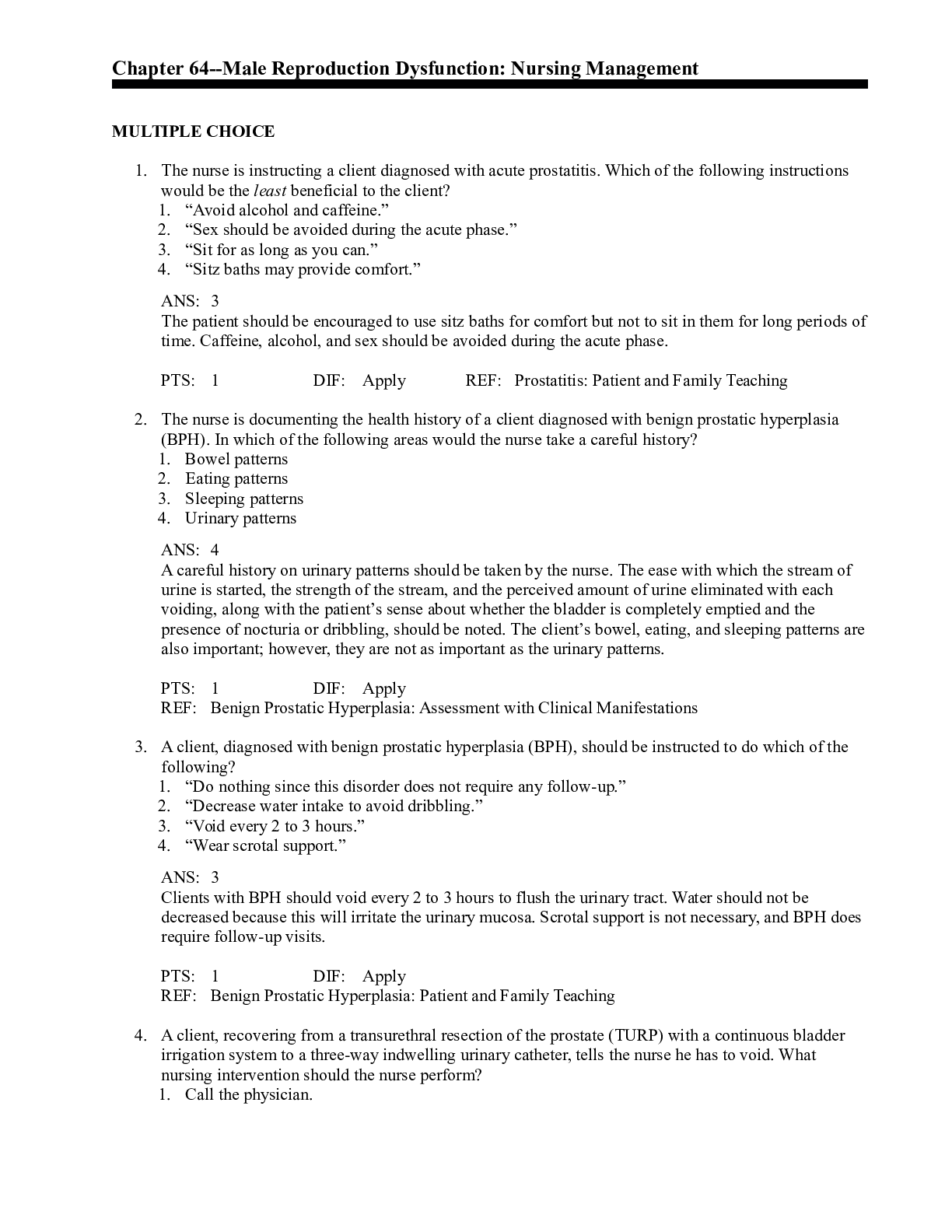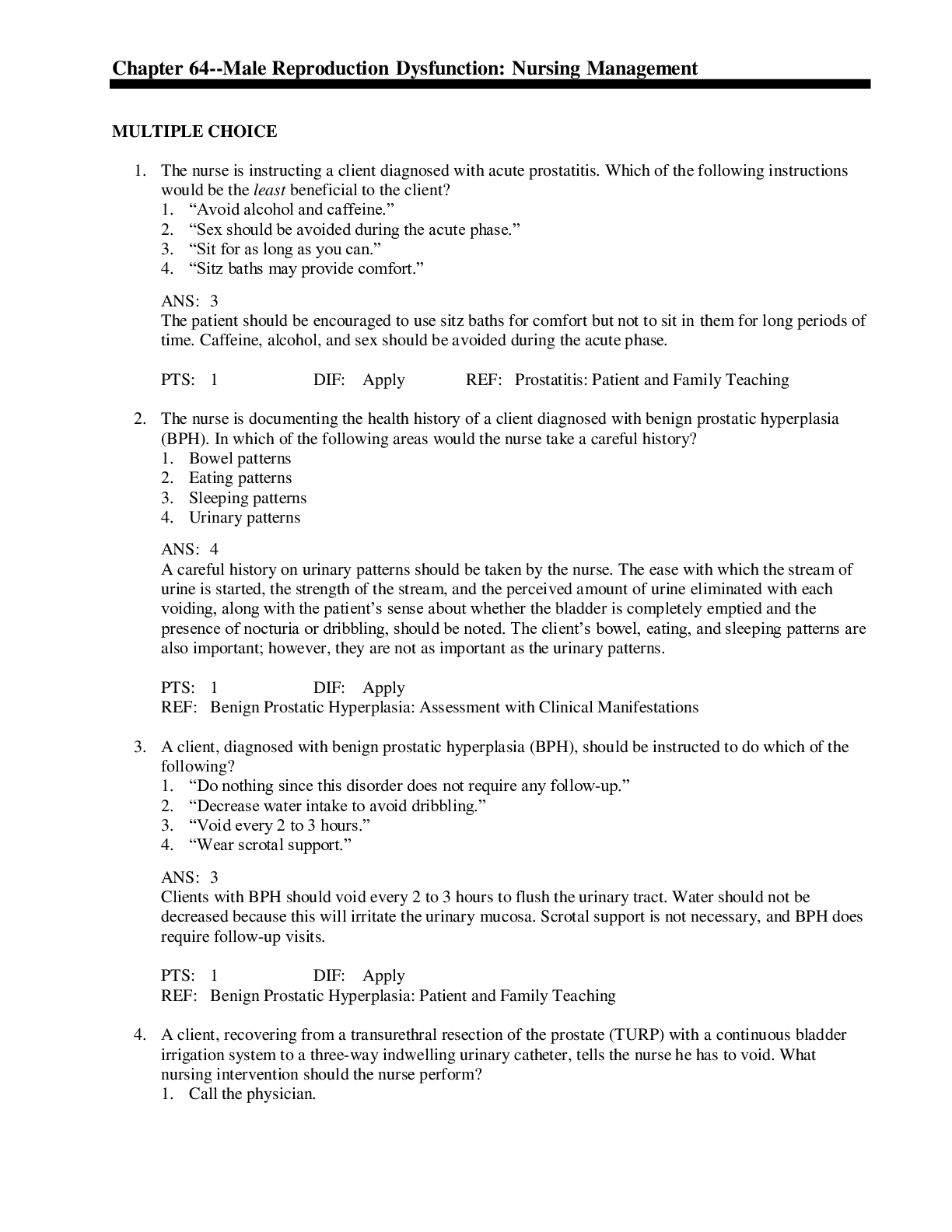*NURSING > QUESTIONS & ANSWERS > Chapter 64--Male Reproduction Dysfunction: Nursing Management (All)
Chapter 64--Male Reproduction Dysfunction: Nursing Management
Document Content and Description Below
Chapter 64--Male Reproduction Dysfunction: Nursing Management MULTIPLE CHOICE 1. The nurse is instructing a client diagnosed with acute prostatitis. Which of the following instructions would be the... least beneficial to the client? 1. “Avoid alcohol and caffeine.” 2. “Sex should be avoided during the acute phase.” 3. “Sit for as long as you can.” 4. “Sitz baths may provide comfort.” PTS: 1 DIF: Apply REF: Prostatitis: Patient and Family Teaching 2. The nurse is documenting the health history of a client diagnosed with benign prostatic hyperplasia (BPH). In which of the following areas would the nurse take a careful history? 1. Bowel patterns 2. Eating patterns 3. Sleeping patterns 4. Urinary patterns PTS: 1 DIF: Apply REF: Benign Prostatic Hyperplasia: Assessment with Clinical Manifestations 3. A client, diagnosed with benign prostatic hyperplasia (BPH), should be instructed to do which of the following? 1. “Do nothing since this disorder does not require any follow-up.” 2. “Decrease water intake to avoid dribbling.” 3. “Void every 2 to 3 hours.” 4. “Wear scrotal support.” PTS: 1 DIF: Apply REF: Benign Prostatic Hyperplasia: Patient and Family Teaching 4. A client, recovering from a transurethral resection of the prostate (TURP) with a continuous bladder irrigation system to a three-way indwelling urinary catheter, tells the nurse he has to void. What nursing intervention should the nurse perform? 1. Call the physician. 2. Increase the flow of the irrigant. 3. Irrigate the catheter. 4. Tell the client to void. PTS: 1 DIF: Apply REF: Benign Prostatic Hyperplasia: Surgery 5. A client who is 12 hours postoperative after a transurethral resection of the prostate (TURP) is concerned about the blood clots in the catheter and urinary collection bag. How should the nurse respond? 1. “I need to call your physician.” 2. “I will need to stop the bladder irrigation.” 3. “Blood clots are common during this time frame and will start to decrease in a day.” 4. “You need to stop moving and irritating the catheter.” PTS: 1 DIF: Apply REF: Benign Prostatic Hyperplasia: Surgery 6. A client is being screened for prostate cancer. What tests would be completed at this time? 1. Digital rectal examination and transrectal ultrasonography 2. Biopsy of the prostate and magnetic resonance imagery 3. Complete blood cell count and prostate-specific antigen 4. Prostate-specific antigen (PSA) and digital rectal examination PTS: 1 DIF: Analyze REF: Prostate Cancer: Assessment with Clinical Manifestations 7. The nurse is instructing a client about testicular self-examination (TSE). Which of the following would not be included in these instructions? 1. “The testis should feel smooth and egg-shaped.” 2. “Perform TSE after a bath or shower.” 3. “TSE should be performed monthly by every male older than age 40.” 4. “Any lumps and changes in the testicles should be reported.” PTS: 1 DIF: Apply REF: Testicular Cancer: Planning and Implementation 8. A male client is diagnosed with orchitis. The nurse should assess the client for which of the following? 1. Recent infection with mumps 2. Recent diagnosis of prostatitis 3. History of type 2 diabetes mellitus 4. Diagnosis of renal insufficiency PTS: 1 DIF: Apply REF: Orchitis 9. A client is diagnosed with a spermatocele. The nurse should instruct the client on which of the following? 1. The use of heat to reduce the size of the inflamed area 2. The potential need for surgery to correct the disorder 3. The use of ice packs to reduce the size of the inflamed area 4. The importance of using antibiotics to treat the disorder PTS: 1 DIF: Apply REF: Hydrocele, Hematocele, and Spermatocele: Surgery 10. A client is diagnosed with a varicocele. The nurse realizes that this client is likely to develop: 1. hydrocele. 2. prostate cancer. 3. prostatitis. 4. infertility. PTS: 1 DIF: Analyze REF: Varicocele: Pathophysiology 11. A newborn male child is diagnosed with cryptorchidism. The nurse should prepare to administer which of the following to this client? 1. Intravenous fluids 2. Antipyretic medication 3. Human chorionic gonadotropin medication 4. Antibiotics PTS: 1 DIF: Apply REF: Cryptorchidism: Planning and Implementation 12. A client is experiencing priapism. Which of the following should the nurse do first to help the client? 1. Apply ice packs to the perineum. 2. Prepare for emergency surgery. 3. Prepare for an aspiration of blood from the penis. 4. Apply heat to the perineum. PTS: 1 DIF: Apply REF: Priapism: Planning and Implementation MULTIPLE RESPONSE 1. A client is diagnosed with testicular torsion. Which of the following might be indicated for this client? (Select all that apply.) 1. Manually untwist the testicle 2. Orchiopexy 3. Testicle removal 4. Pain management 5. Application of ice and a scrotal support 6. Prescribe medication PTS: 1 DIF: Apply REF: Testicular Torsion: Planning and Implementation 2. A client is diagnosed with epididymitis. The nurse should instruct the client on which of the following as treatment for the disorder? (Select all that apply.) 1. Broad spectrum antibiotics 2. NSAIDs 3. Bed rest 4. Elevate the scrotum 5. Apply cold packs 6. Apply heat PTS: 1 DIF: Apply REF: Epididymitis 3. Which of the following should the nurse instruct a client who is recovering from a vasectomy? (Select all that apply.) 1. “Use ice packs to control postoperative bleeding.” 2. “Wear cotton jockey type briefs for scrotal support.” 3. “Use warm sitz baths to aid in comfort.” 4. “Recognize the signs and symptoms of postoperative infection.” 5. “A vasectomy protects the client from sexually transmitted illnesses.” 6. “Ejaculate will be reduced after the procedure.” PTS: 1 DIF: Apply REF: Vasectomy: Patient and Family Teaching 4. The nurse is assessing a client diagnosed with balanitis and posthitis. Which of the following will the nurse most likely assess in this client? (Select all that apply.) 1. Penile discharge 2. Hematuria 3. Pain 4. Erythema 5. Flank pain 6. Edema PTS: 1 DIF: Apply REF: Balanitis and Posthitis: Assessment with Clinical Manifestations 5. The nurse is assessing a client who is experiencing erectile dysfunction. For which of the following should the nurse assess the client? (Select all that apply.) 1. Diagnosis of diabetes mellitus 2. Thyroid disease 3. Chronic renal failure 4. Multiple sclerosis 5. Parkinson’s disease 6. Gastroesophageal reflux disease PTS: 1 DIF: Apply REF: Erectile Dysfunction: Etiology [Show More]
Last updated: 1 year ago
Preview 1 out of 5 pages

Buy this document to get the full access instantly
Instant Download Access after purchase
Add to cartInstant download
We Accept:

Reviews( 0 )
$5.00
Document information
Connected school, study & course
About the document
Uploaded On
Jan 21, 2020
Number of pages
5
Written in
Additional information
This document has been written for:
Uploaded
Jan 21, 2020
Downloads
0
Views
57















